Olive Ridley Turtle Festival, Velas Beach, Maharashtra
Every Year November to December the two feet long adult female Olive Ridley Turtles also known as Pacific Ridley Turtles, return to the sands to nest. The turtles create a sand pit laboriously digging with their flippers and lay 80 or more eggs at a time. Left to incubate thus, these eggs hatch in about six months around March and April.
The Turtle Festival begins around 10th March and lasts till mid April.
But these turtles are now among the endangered species. Reason? Of course the humans! The turtles are losing their nesting grounds as man has usurped the beaches in hordes.
Known for ‘arribadas’ or synchronised mass nesting behaviour, majority of Indian Ocean turtles have chosen Gahirmatha, Odisha as one of the nesting grounds. In recent years another nesting ground has emerged for these turtles at Velas, Maharashtra. (Explore more beaches here)
Velas, a village in Ratnagiri was birth place of one Nana Phadnis, an important figure in the Peshwai, Pune. A small memorial stands in the village for him.
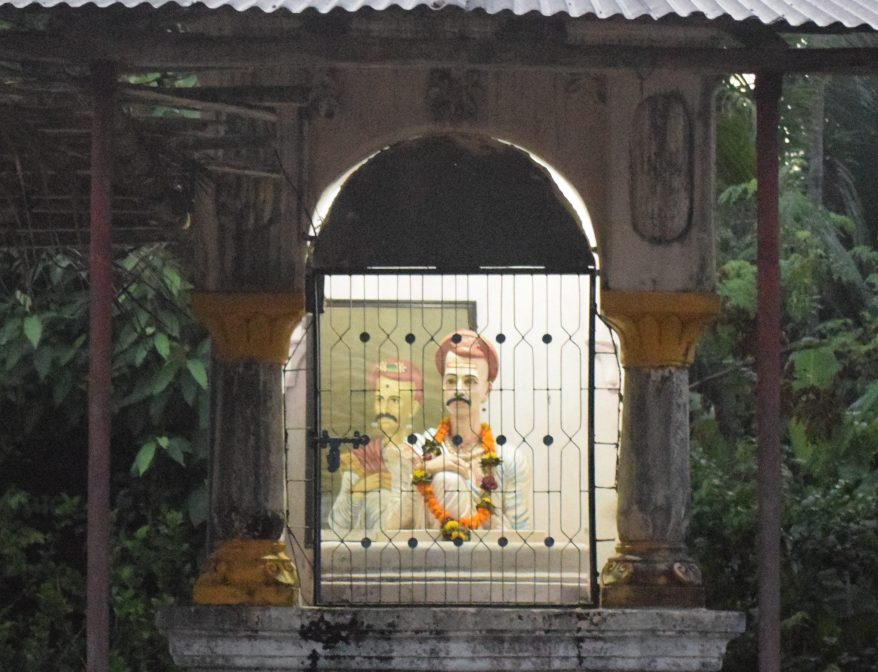
Memorial for Nana Phadnis
The people of Velas, now work towards the conservation of these turtles by protecting the eggs and hatching them in controlled condition.
Seeing wildlife in its natural habitat is becoming a rarity with most animals reducing in number. On a jungle safari at Jim Corbett National Park, I missed the sighting of tiger. And so I had been wanting to visit Velas ever since I heard about the Turtle Festival to watch baby turtles crawl and swim towards the lap of ocean. A weekend trip from Pune did materialize eventually.
After an over night travel via Tamhini Ghat on a bumpy hill road, I reached the village of Velas early morning. And while the rest of village slept, the tour guide, Suraj, a young lad who volunteers for such trips, egged the tour group to refresh as quickly as possible and scuttled us all to the beach.
The sleepy village path opened up near a small mangrove. A muddy trail skirting the mangrove led us through the pine trees to the beach that stretched for miles with silver sand dotted with numerous big and small holes dug by crabs of various sizes. At the farther end of the beach the western ghats sat dominating the skyline overlooking the gorgeous blue waters.
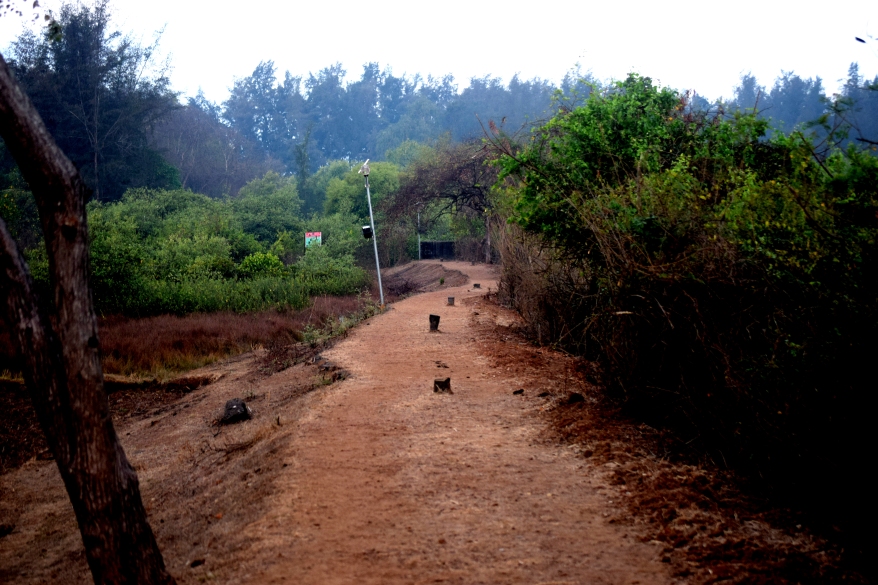
To the beach
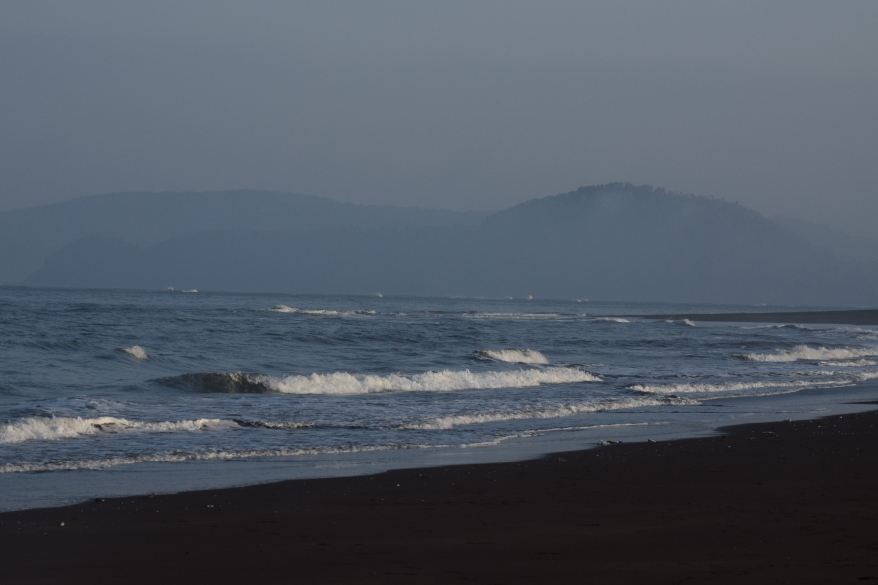
Velas beach
Interesting fact is that a female turtle after laying the eggs does not nurture the babies. The eggs hatch in the pits covered by sand and the baby turtles find their way out of the pit. Natural instinct makes the newly hatched turtles seek the ocean, their habitat. In their struggle to reach the sea, the baby turtles need to travel across the sandy expanse between the nest and water. It is during this journey that the babies fall prey to eagles, stray dogs, foxes and humans.
With the dwindling number of the species, the Maritime committee along with Maharashtra Tourism and Gram Panchayat at Velas came up with the solution of protecting the hatched turtles thus working towards conservation of the endangered species. The trained villagers replicate the nest of the turtles by digging exactly same size of nest in a protected part of the beach and shift the unhatched eggs to the new nests. These pits are covered with cane baskets to ward off dogs and eagles.
Each nest thus replicated is marked with dates to keep track of probable time of hatching. At the end of incubation period, each basket is removed to uncover the nest and the baby turtles that emerge are collected to be released in sea. The eggs that remain unhatched are left for further incubation in the pit.
When our group reached the beach early morning, the baskets were just being opened to count the hatch-lings. As each basket was raised, a whoop of joyous cry escaped the onlookers.
Every visitor was rejoicing in the new born life. Each visitor was celebrating the success of struggle to survive.
That morning recorded the highest number of hatching since the festival began this year with 84 baby turtles in all. The tourist could not contain their happiness. All wanted to witness the slow crawl of the babies towards the ocean. We all soon gathered around the barricade where the turtles were to be released.
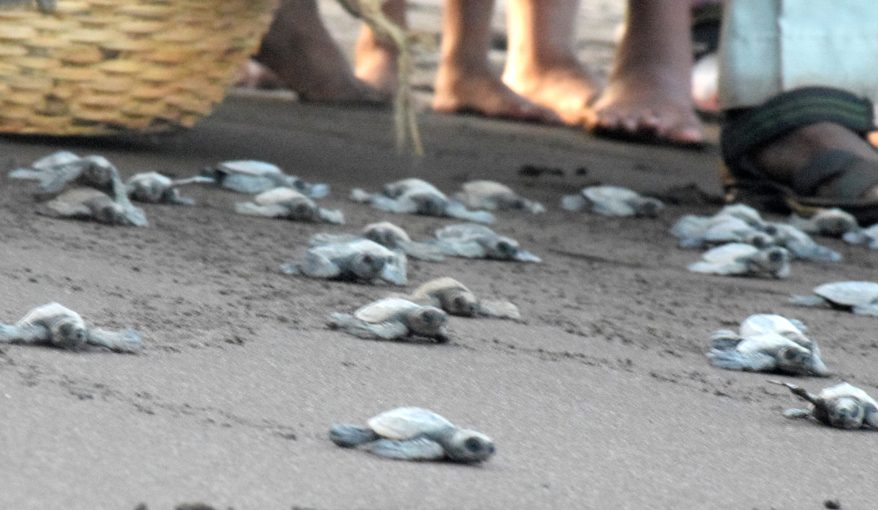
Ready to seek ocean
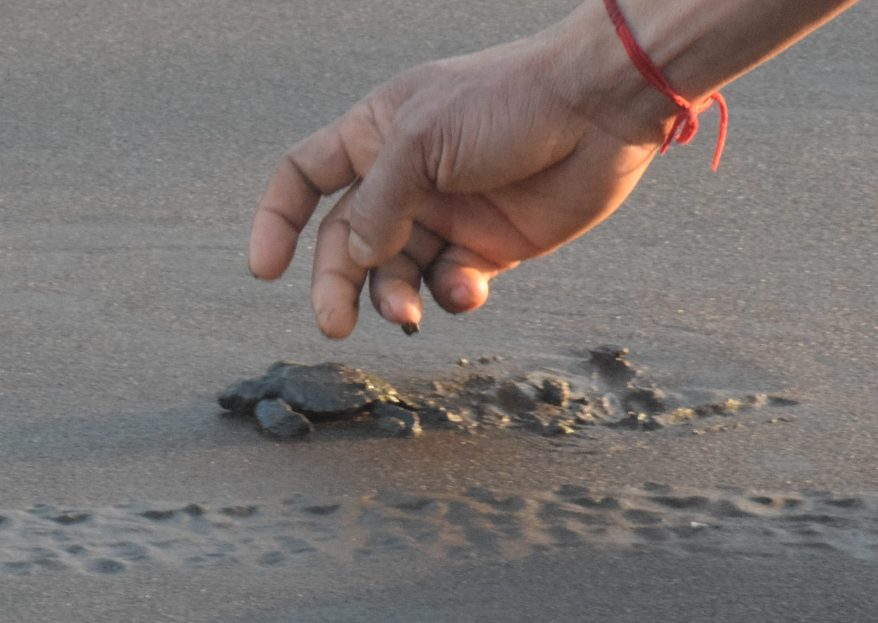
Off you go little one

Meeting the ocean
No sooner had the baby turtles touched the sand that instinct took over and they began their labored journey towards the ocean leaving behind interesting trails on the sand. Some babies trailed back away from sea and were promptly diverted back. Gradually the 84 tiny turtles reached closer to the water and the ocean sent out its gentle wave to take the water babies into its fold.
And just like that everything was over…the babies were gone.
The beach was left for humans to frolic once again. I walked down the beach and to my horror at the farther end of beach found plastic waste strewn in the sand. I wondered and worried that if two months of tourist activity could cause so much of waste to generate, what it would be like when resorts came up on this secluded pristine beach?
I vote a no for resorts. How about you? Do you think conserving ecology and wildlife will do more good for this earth and us or fun activities that are slowly eating into natural habitats of wild life?
A Few Reminders:
- Every one loves to see wildlife but it is a good practice to not chase and scare the poor animals.
- Turtle babies are very vulnerable. Switch off flash lights of cameras and mobiles. Turtles move towards natural light horizon. Flashes disturb their sense of direction.
- Do not use drones, it causes unnatural sound frequency for turtles.
- Do not stand in water when the turtles swim towards sea. They get washed up with waves and might get trampled.
- Do not block the sea side when turtles are making their way towards sea. Imagine being surrounded by danger from all side. How would you react? Be compassionate. Let the turtles swim freely towards water.
- Plastic straws and other wastes are the biggest killers of turtles as it lodges in their nostrils and causes a slow painful death. Do not litter on beaches and prevent your kids from doing so.
- Respect local sentiments when staying in home-stays. Do not litter as the families do all work themselves and do not have separate housekeeping staff.
Stay:
- There are 35 home stays at the Velas Village.
- Room rents vary from Rs 800 to 1000 for AC/non Ac option. Meals extra charges.
- Dormitory rents vary from 900 Rs to 1200 Rs depending on vegetarian or no-vegetarian meal options.
- Home stays offer very basic facilities. The bathrooms have water but are generally unclean.
- Most homes do not allow usage of sleepers and shoes inside the house.
- Meals are freshly prepared and warm.
- I stayed at homestay of Mr Prakash Nitsure. Get in touch with him at 02350-220328/29 for home stay booking.
- None of the mobile services receive signal at the village and you are cut off from cities literally.
- Take your own medical supplies, torches, and sanitary kits since hospitals and bigger shops are not close by.
Reaching there:
- Coastal village of Velas is connected by road to Pune, Mumbai, Ratnagiri.
- State transport buses, private taxis ply the route.
- It takes roughly 5 hours or little more from Pune to drive till Velas village with the distance being approximately 195 kilometer. Mumbai is 225 kilometer from Velas.
- I travelled with Mumbai Travellers Vacations tour operators in a private mini bus with 15 other tourists from Pune.
- Nearby places like Harihareshwar, Anjarle, Dapoli and Shreevardhan are also easily accessible and worth a visit.


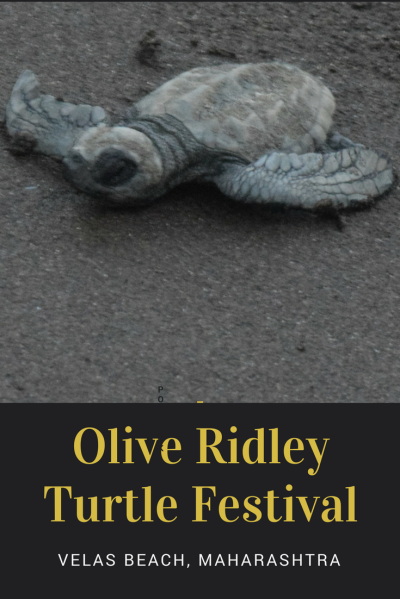
glad you could make a visit there, I also want to witness this
Initiative for conservation of wildlife and ecosystem is good approach towards saving endangered spieces
glad to know about this
LikeLike
glad you could make visit here.Glad to here that tourism and village people trying to conserve the endangered wildlife
Lovely the post shoma
LikeLike
Yes I finally saw the turtles. But people were blocking the sea side too beyond the barricade and village members had to again and again request people to not block the passage as the babies could be trampled.
LikeLike
Nice to read about Turtle Festival.
Beautiful pics.
LikeLike
Thank you Rupam
LikeLiked by 1 person
fantastic nature post
LikeLiked by 1 person
Thank you Pushpendra
LikeLike
Wow beautifully written
LikeLiked by 1 person
Thank you Deepali. Glad you liked it. It was great trip.
LikeLike
Nice and very detailed post 👍 Shoma
Thanks for sharing 🙂
LikeLiked by 1 person
Thank you Sachin
LikeLike
Thanks for sharing! Great article Shoma, I was not aware of this..
LikeLiked by 1 person
Thank Rashmi. It was so beautiful
LikeLike
Great post ! Covered up everything precisely 🙂 Keep Glittering ! Rise N shine ❤ Love TGA by Misha
LikeLiked by 1 person
Thanks
LikeLike
ऑलिव रिडले कछुए के बारे में इससे अधिक सारगर्भित लेख कही नही हो सकता। आप जैसी अगर वैज्ञानिक लेखों की लेखिका हिंदी में होती तो शायद भारत की विज्ञान व्यवस्था की तस्वीर कुछ और ही होती। आपने गहिरमाथा तक मादा कछुआ की यात्रा और उसके बाद उसके कछुआ पैदा करने की यात्रा को बेहद शास्त्रीय ढंग से समझाया।☺️☺️☺️
LikeLike
इस प्रकार की प्रशंसा के लिए धन्यवाद। एक छोटी सी कोशिश है लोगों तक विभिन्न जानकारी पहुँचाने की। परन्तु मैंने गहिरमाथा का सिर्फ उल्लेख ही किया है कहानी तो महाराष्ट्र के वेलास गाँव की है।
LikeLiked by 1 person
What a wonderful story, Shoma. Very heartening to read and love your opinions on tourism 🙂
Thanks for sharing.
LikeLiked by 1 person
Thank you Shubham. You being such an avid traveler, your opinion makes my day.
LikeLiked by 1 person
India is an amazing place to visit. Full of nature.
LikeLike
It sure is. Must visit.Thanks
LikeLike
I visited Anjarle to witness this phenomenon in the first week of March but unfortunately, that day not a single egg hatched. I now realize that it was a bit early for the hatchings. Anyways, enjoyed it through this blog post. 🙂
LikeLiked by 1 person
Thank you. I am glad you enjoyed. I will probably go to Anjarle next time. It’s less crowded I heard.
LikeLike
Less crowded than most of the beaches around (like harihareshwar, shrivardhan and diveagar) but haven’t been to Velas yet so can’t comment on that.
LikeLike
Velas was a mob literally.
LikeLike
My visit was a peaceful one. But I wonder that would be the case during the peak season of hatching.
LikeLike
That would be certainly crowded. It has become quite popular now for the turtle sighting.
LikeLike
Very nice pictures & article, you have shared on Turtle.
This is favorite, Thank’s A lot.
LikeLike
Thank you Ranjeet. Keep reading.
LikeLike
Description is too good…
LikeLiked by 1 person
Thank you much
LikeLike
Very Nice post you have shared for us.
Thanks a lot
LikeLiked by 1 person
Thank you so much. I am glad you like the post
LikeLike
I adore such events that support the environment and wildlife and bring people to the thought that we must preserve and save our nature for future generations.
LikeLiked by 1 person
It’s indeed heartening to see little creatures crawl towards sea. Wildlife is beautiful. Hope more and more of it is saved for our own benefit and next generation
LikeLike
Turtle is a rare animal. I think that most people want to conserve important animals and protect them better.
Besides, people can track the development of animals through some applications on the mobile phone. You can check user experience of people who use those apps.
LikeLike
i hope more animal lovers grow in numbers. thank you for reading
LikeLike